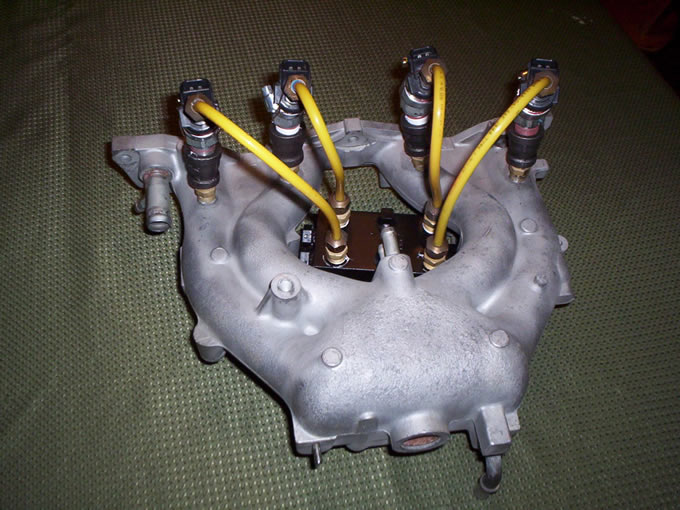The system consists of a hydrogen tank, a pressure regulator two cut off valves, a distribution manifold and 4 fuel injectors.
Hydrogen Gas as a Supplemental Fuel for Automobiles
Tom Pettit
I got interested in hydrogen gas as a supplemental fuel for automobiles 4 years ago and I started a small company THE FUEL CELL RANCH to study hydrogen and its effects on automotive engines. THE AURORA PROJECT was born and since then I have been fascinated and compelled to design a reliable and safe system that saves gas and helps cut down on harmful emissions.
My first attempts with hydrogen production were somewhat successful.
I used electrolysis to produce the hydrogen and fed it to the intake of a engine.
I was able to achieve a 15% mileage increase and a better running cleaner burning engine. This unit lasted about 4 months and started to leak electrolyte, this led to structural problems and the demise of the unit shortly after.
Several more units where built but with no success and previous results could not be achieved so I decided to take a different approach and direct inject the hydrogen into the engine as if it where gasoline.
The best way to do this was to use fuel injectors one in each intake runner and time the hydrogen injection with the gasoline injectors so they both open and close at the same time. The system consists of a hydrogen tank, a pressure regulator two cut off valves, a distribution manifold and 4 fuel injectors.

Very little hydrogen will be in the intake plenum at any given time, so intake backfires will be less likely.
The hydrogen injection is controlled and calculated by the Ecm (engine control module) and seems to be the most logical solution to a very difficult problem.
Fuel curve maps show the amount and duration of fuel being injected and the hydrogen can be trimmed by regulating the pressure from 1 to 5 pounds at the injector. At this time a manual adjustable regulator is all funding will allow.
Hydrogen is stored in the trunk of the car in a industrial tank that is safe and easily filled.
80 cubic feet of hydrogen will last about 20 days according to the miles I drive weekly at a cost of one dollar per day the savings well outweighs the cost.
My goal is 50 mpg, I am averaging 42.5 mpg now with no hydrogen.
The test vehicle I am using is a 4 cylinder 5 speed that is in tune and a free flowing exhaust system has been added. This system is very simple and I hope to have a full system test soon.
I will write a follow up article as soon as more information is available.
The content & opinions in this article are the author’s and do not necessarily represent the views of AltEnergyMag
Comments (0)
This post does not have any comments. Be the first to leave a comment below.
Featured Product

MORNINGSTAR - ReadyEdge
The ReadyEdgeTM (RE-1) accessory is an intelligent system controlling and reporting device meant to make monitoring your solar energy system more transparent. Enabling access to LiveViewTM 2.0 and Morningstar Solar ConnectTM, ReadyEdge provides data from all compatible Morningstar devices in your system. It is designed to be paired with the three ReadyBlock options, up to six total, with the possibility to use multiple ReadyShunts and ReadyRelays. The ReadyEdge is compatible with select Morningstar products.
